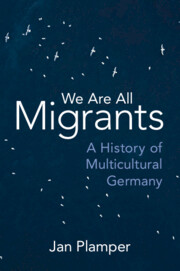
I had done twenty-odd discussion events around my book in East Germany, but this was something else. “If they start disturbing, or if things turn violent, just push the red button and the police will come,” said the representative of the local antiracist citizen group that had invited me to Chemnitz, pointing to a contraption underneath the rostrum. I had come to understand that pro-migrant activists were fighting an uphill battle against neo-Nazis in many parts of Eastern Germany, that I would never get invited to the towns where the extreme right was all-dominant, that it was a good sign if there was an antiracist civil society at all, and that outsiders could best contribute to resisting the extreme right through supporting that existing local East German civil society. I had also learned that there was considerable frustration with some West German leftists who were seen to play down their own regions’ problems with racism by comforting themselves that these were restricted to the former GDR. Yet the prospect of violence and the red button were new.
No one ended up disturbing or crashing the event on 28 February 2020, Peace Day, organized by the local citizens’ initiative Aktion C to counter the narrative of self-victimization that neo-Nazis always rallied around this time of year to commemorate the 1945 aerial bombing of Chemnitz by the Royal Airforce and the United States Airforce. In a mixture of speaking freely and reading passages I took the audience through the book, which is now available in my own English translation as We Are All Migrants: A History of Multicultural Germany.
Humans, I said, have been migrating since time immemorial. The Germans were particularly active outmigrants until the twentieth century, with North America and Russia serving as the main destinations. After 1945, Germany herself became a major destination of immigration—12.5 million German expellees from Eastern Europe who arrived at the end of the Second World War; 14 million “guest workers” from Italy and Turkey who were recruited for the West German economy between 1955 and 1973; the GDR’s Vietnamese and Mozambican labor migrants of the 1980s; 2.3 million Germans and 230,000 Jews who came from the Soviet Union after 1987; and the asylum-seekers from Iran and Sri Lanka during the 1980s, Yugoslavia in the 1990s, and Syria in 2015. What was migration like for them? How did they experience living in the country with arguably the most primordialist, ethnobiological understanding of nationhood on the European continent? And where does this entrenched primordialism come from, given that Germans have been among our planet’s most active migrants and given that Germany only came into being as a nation-state in 1871?
Oral histories and first-person sources like autobiographies and memoirs form the backbone of the book and allow me to narrate the lived experience of migrants in their own voices. There is Alev Yildirim, born in Berlin in 1971 and a second generation “guest worker,” who in 1997 as rapper Aziza A. with her song Es ist Zeit (It’s Time) landed the first hit with German lyrics and a Turkish refrain. When her career took off, she remembers getting asked “stupid questions like, well, what are you actually?” and “how many percent are you Turkish, how many percent German?” Her response: “Yeah, sure, I’m a cheese, 60 percent of me is fat, the rest is German and the rest is Turkish, or what do you mean?” There is 1963-born Ibraimo Alberto who arrived in East Berlin in 1981 from Mozambique for “contract work” at a meat factory. In 2013, after decades of working, winning boxing championships, marrying, living through the end of the GDR and Cold War in 1989-90, serving as a local council politician, and moving to West Germany because he was afraid for his children after experiencing increasingly open racism, he travels to Maputo to get back the 40 percent that the Mozambican functionaries used to subtract every month from his GDR contract worker salary. Without taking his eyes off his computer screen, a clerk at the labor ministry tells him: “Well, bad luck. You’re too late. I don’t understand why you didn’t get in touch earlier.” After Alberto has proved that he did try to get his compensation on time, the voice behind the screen says: “Write a letter to the minister. You have to lie in it, though, you understand? You have to make up a reason why you only got in touch now. Perhaps a disease, is that an option?”
The overarching story that emerges is one of incredible hardship and brutal racism, but also one of overcoming and success. Immigrants juggle multiple attachments and have forged a more hybridic, less “blood”-based, less fixed definition of Germanness, one in which one can for instance be more comfortably both a German citizen and of Eritrean or Romanian descent. I propose calling these citizens PlusGermans, a self-descriptive term coined by German citizens Tayfun Keltek, a politician, and Joybrato Mukherjee, President of Gießen University, who says, “I feel German, I was born here and grew up here, and I feel most at home in the German language.” He also says: “My family has a strong Indian identity, and I am a member of the Hindu faith.”
My book also suggests a collective identity, a “New We” (Das neue Wir, as in the German book title), with a dual meaning: on the one hand the term is meant to designate all German citizens without exception (visible minorities must no longer be excluded, as is still too often the case), on the other it proposes a symbolic-emotional celebration of civic nationhood. Not offering anything by way of collective German identity, leaving an empty space, is problematic for at least two reasons. First, it is antidemocratic if not outright paternalistic, as it is empirically proven that many immigrants—especially those from places where the nation is not an empty space—would like to identify as Germans symbolically and emotionally. Second, the siren calls of former empires that have recently turned to ethnobiological/ethnoreligious definitions of nationhood are getting louder and falling on fertile ground where there is a vacuum—I am thinking of Germans of Turkish heritage and Recep Erdogan’s AKP or of Germans of (post)Soviet extraction and Putin’s “Russian world” propaganda.
That said, the book does not propose a content for this second meaning of “The New We.” That content is by definition contested and can only be democratically determined within the confines of the German constitution so that no one’s basic rights are violated. To give an example, what should a naturalization ceremony look like? At present, the handing over of a passport is at best symbolically marked at the local level, say a particular Berlin district. But don’t new citizens join the nation-state of the Federal Republic of Germany? Which national symbols should be shown, what music played? How best to represent particularist heritage identities and a collective national identity: e pluribus unum, one out of many? Why not have competitions, commissions, and ultimately a parliamentary decision on these questions?
If you walk the streets of Berlin today—or Chemnitz, for that matter—you will encounter cars with Ukrainian number plates, read bar menus offering “Kyiv Mule,” “Moscow” struck through in thick red, and hear a lot of Ukrainian spoken. Since Russia’s attack of Ukraine on 24 February 2022, a million Ukrainians have found refuge in Germany, 100,000 of them in Berlin. How many of them will stay, how they will fit into German society and in the process remake German society, remains to be seen. One thing is certain: they will not be the first ones but only the latest group because, ultimately, we are all migrants

Latest Comments
Have your say!